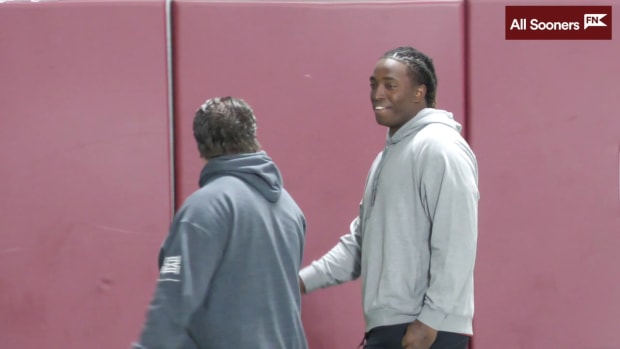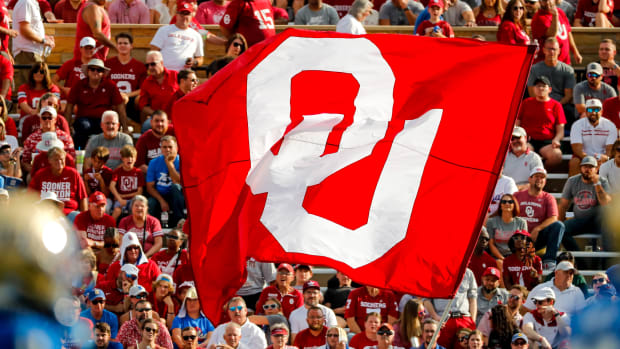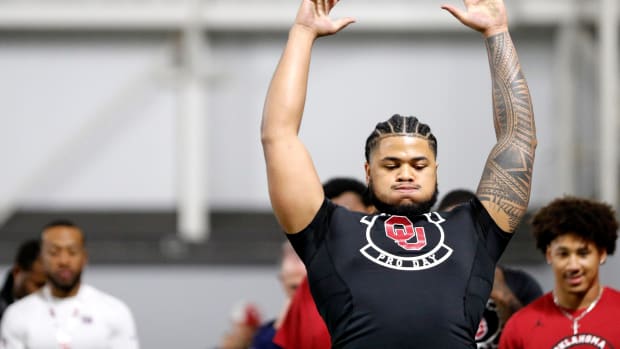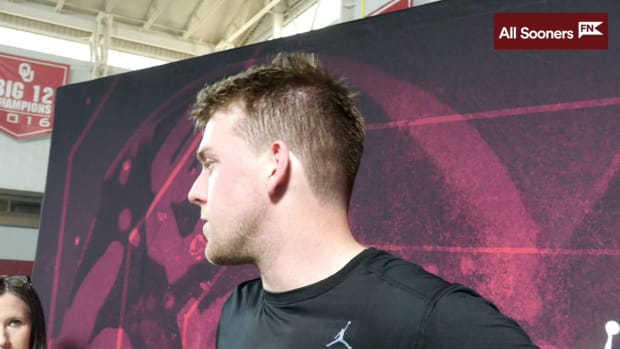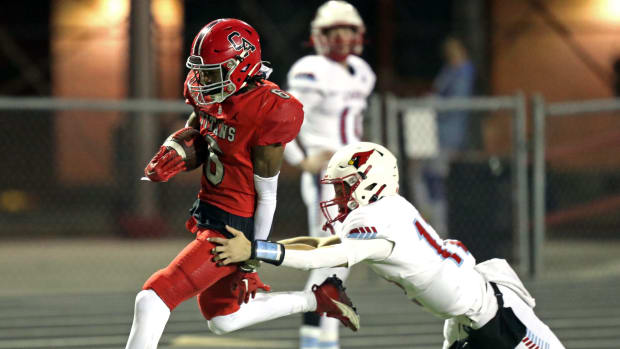Recruiting ROI, No. 15: Chris Brown
Every Tuesday and Thursday, SI Sooners will unveil a new installment in the Recruiting ROI series. Over the course of ten weeks, the series will examine 20 Sooners over the last 20 years who dramatically exceeded expectations in the crimson and cream.
It's quite remarkable to look back on the wealth of offensive talent that Bob Stoops stockpiled in Norman in the late 2000s.
What's even more remarkable is that none of those exceptional Sooner teams were able to secure a national championship, despite owning some of the most prolific offensive units in college football history.
Consider this: in 2006, Oklahoma rostered five — count 'em, five — running backs that would eventually sign NFL contracts.
Ask any Sooner fan who those five backs were, and anyone worth their salt could name Adrian Peterson. Nearly all would be able to identify DeMarco Murray. Many could recall Allen Patrick as well. Some, especially those with longstanding local ties, could probably come up with Mossis Madu.
But the final member of that ballyhooed quintet might slip more than a few minds, especially considering the ubiquity of his name.
Indeed, despite his consistent production and noted nose for the end zone, Chris Brown ranks as one of the forgotten stars of the era.
Coming out of high school, Brown wasn't a nobody by any means — he earned a four-star rating, and chose Oklahoma over offers from LSU, Mississippi State, Arkansas and TCU. But he didn't strike anybody as a future workhorse in the Oklahoma backfield, due in large part to the Sooners' ridiculous depth at running back.
Everyone knew Peterson was a generational talent, and the only question was how soon he'd make the jump to the NFL. Patrick was a top two-way talent on the junior college circuit, and committed to Oklahoma as a safety before switching to running back.
Then the Sooners hit the motherlode with their 2006 recruiting class, scoring Murray, Madu and Brown. Murray was a five-star recruit out of Las Vegas, one of the top backs in the class. Madu was a hometown hero who rocketed to acclaim with a standout senior season at Norman High. Brown was seemingly just a depth addition, a career backup who could adequately fill the void in case of catastrophe.
It didn't take him long to turn that narrative on its head.
As freshmen in 2006, Murray and Madu redshirted, but Brown remained active. That decision paid off in spades for all involved, as Peterson went down with a broken collarbone midway through the season. Patrick suddenly became the lead back, which thrust Brown into the picture as the de facto change of pace. He averaged 4.9 yards per carry down the stretch and found the end zone six times.
Peterson would later forego his senior year to enter the NFL Draft, and Patrick entered the 2007 season as the bell cow. Murray emerged to supplant Brown as the No. 2 back, due in large part to his aplomb as a pass-catcher.
Nevertheless, even as the third-stringer, Brown would make his presence felt.
Heading into the season, an unheralded sophomore quarterback named Sam Bradford rose from obscurity to claim the starting job, and the Sooner offense exploded. There were plenty of touches to go around in the Oklahoma backfield — Patrick led the way with 1,009 yards on the ground, Murray accounted for 824 all-purpose yards and 13 touchdowns, and Brown rushed for 611 yards and nine scores of his own.
After a season that culminated in a Fiesta Bowl loss to West Virginia, Patrick graduated and became a seventh-round pick of the Baltimore Ravens. His departure set the table for Brown and Murray to run the show in 2008.
Few could have predicted what a statistical boon the campaign would bring for every member of the Oklahoma offense.
The Sooners wiped the floor with the Big 12, their only stumble coming in a 45-35 loss to Texas. Bradford annihilated the school record books, throwing for 4,720 yards and 50 touchdowns on his way to the Heisman Trophy. Oklahoma scored 50-plus points nine times on the year. Murray accrued 1,397 all-purpose yards and 18 touchdowns, but it was Brown who stole the show in the ground game.
He kicked off the year with three rushing touchdowns against Chattanooga, one of four hat tricks on the season. Brown had several strong games early in the season (107 yards at Washington, 142 yards and a TD at Kansas State). But once the calendar flipped to November, he absolutely caught fire, and the Sooners began to steamroll the opposition.
Brown rushed for 89 yards and a score in a 62-28 win over Nebraska, adding a receiving touchdown as well. The next week, he throttled Texas A&M for 117 yards and three touchdowns in a 66-28 triumph. After an open date, he romped for 108 yards and three more scores in the infamous "Jump Around" game, and Oklahoma immolated second-ranked Texas Tech 65-21. Then, two days after Thanksgiving, Brown had leftovers in store for Oklahoma State. He closed out an otherworldly month with 98 yards and two scores in a 61-41 Bedlam victory.
If that weren't enough, he rambled for 122 yards and another trifecta of touchdowns in the Big 12 title game the following week. After Murray went down with an injury on the game's opening kickoff, Madu also shined with 114 rushing yards and three TDs of his own, and the Sooners romped 62-21 over Missouri on their way to a national championship berth.
Though Oklahoma would fall 24-14 to Florida in the BCS title game, Brown was one of the lone bright spots, racking up 110 yards on 22 carries. On the season, he accumulated 1,220 rushing yards on 217 totes, an average of 5.6 yards per carry. Most impressively, he rushed for 20 touchdowns, a season total that's only been surpassed by three Sooner backs (Steve Owens, Billy Sims, Samaje Perine).
The 2009 season brought no shortage of turmoil, as Bradford separated his shoulder in the season opener against BYU. He returned a month later and led Oklahoma to a 33-7 win over Baylor, but re-injured the shoulder the following week against Texas and missed the remainder of the season. Redshirt freshman Landry Jones struggled to catalyze the Sooner offense, and Brown's production suffered. He managed a respectable 749 rushing yards and seven touchdowns on the season, but Oklahoma sleepwalked to an 8-5 record and an appearance in the Sun Bowl.
Brown signed with the Denver Broncos as an undrafted free agent, but never cracked the roster and moved back to his native Louisiana. Sadly, his life soon took a turn for the worse, as he struggled with drug addiction and served several prison sentences before ending up homeless and destitute.
However, KWTV reported last November that Brown is back on his feet. He's returned to Norman, is employed, and maintains sobriety. Though his glory days as a Sooner are long past, Brown wants to get back into football eventually.
It's been a long and tumultuous road for Brown, and he lost nearly everything along the way. But his legacy as a Sooner won't fade. Those 3,246 yards and 45 touchdowns aren't going anywhere.
Chris Brown's name might not be unique, but for all that he did in the crimson and cream, it's a name worth remembering.
To get the latest OU posts as they happen, join the SI Sooners Community by clicking “Follow” at the top right corner of the page (mobile users can click the notifications bell icon), and follow SI Sooners on Twitter @All_Sooners.
